Dave Ramsden's Blog
June 28, 2017
Summer Reading Suggestion: Unsolved!
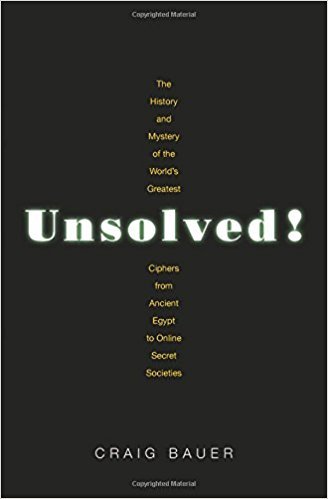
If you’re interested in codes and ciphers, here’s a worthy addition to your summer reading list. Craig Bauer, one of the nation’s foremost authorities on the history of unsolved ciphers (he did a stint as Scholar-in-Residence at the NSA's Center for Cryptologic History), has just come out with a new book- Unsolved!: The History and Mystery of the World's Greatest Ciphers from Ancient Egypt to Online Secret Societies. It’s a great read that covers everything from ancient writings to modern cold cases and some of the more interesting cipher mysteries proliferating the internet today. There is a broad selection of material and Bauer does a great job of keeping it readable and interesting. Here’s a link: http://amzn.to/2rAaPdX

May 25, 2016
Mystic Ciphers Review in Cryptologia

I’m very happy to report that Unveiling the Mystic Ciphers has received a positive review in the latest edition of the scholarly journal, Cryptologia (Vol 40, Issue 4).
For those of you unfamiliar with Cryptologia, it is perhaps the highest regarded journal devoted to cryptology, with a specific focus on the history of codes and ciphers. Its original founders included experts such as David Kahn and Brian Winkel. It was published for years by the US Military Academy at Westpoint, and it is now published by Taylor & Francis.
Craig Bauer, who wrote the review, is a cryptology historian who concentrates on unsolved ciphers. He is the author of Secret History: The Story of Cryptology. He is also a mathematics professor at York College and the Editor-in-Chief at Cryptologia. A link to a preview of the review is below.
http://www.tandfonline.com/doi/abs/10.1080/01611194.2016.1159476

February 11, 2016
The Neuroscience of Change

Achieving meaningful change in an organization can be a daunting task. And it’s not always welcome. While there are some folks who enjoy change, and even champion it to the level of “change-for-change’s-sake,” many more of us resist it. And sometimes with good reason.
Change should always be driven by a purpose. And it better not be because our CEO read a new management book on the red eye home from Las Vegas. We have all experienced those moments when we have a good head of steam going, improving the way we run our organizations, and then someone decides to mess with something.
But sometimes change is actually good for the organization, and it can be vital to achieving growth. Sometimes, it can even be vital to survival. In these instances, it is the leadership team’s responsibility to take ownership of this process, and to stay focused on it from start to finish. Even if they see a shiny new bestseller at the newsstand.
We need this focus because as human beings we are wired to resist change. Neuroscience has discovered that change actually produces a painful physiological response in our bodies. It increases stress and sparks a survival instinct that works against our better judgement. To accomplish anything out of the ordinary we have to behave differently. When we do that, our brain recognizes the deviation from the norm and sets off alarms. Its goal is to stop the new behavior and get things back to normal. And it usually succeeds.
That is why, to my great consternation, so many of my own emails do not accomplish their goal. Have you ever tried to establish a new process by just sending an email? As the sender, I think I made my case pretty clear. I’m proud of the thought I put into convincing people why the change is important. I was clear about what to do in the future. I’m a very special person. My mother was right. Things will go as planned.
Then I click send and all hell breaks loose as the message disappears into a vacuum of excuses. I’m moving on to the next thing, thinking that I don’t have to give my request another thought. Change will come quickly, thoroughly and effectively. Because I sent one email.
The truth is, I should have known better. But here is the good news: our minds resist change, but they can also be remarkably plastic. In order to take advantage of the brain’s plasticity, we need to train it to change. It will resist at first, but curiously, researchers have found that the brain behaves differently when consistent focus is applied.
In their article The Neuroscience of Leadership, David Rock and Jeffrey Schwartz state that “Over time, paying enough attention to any specific brain connection keeps the relevant circuitry open and dynamically alive. These circuits can then eventually become not just chemical links but stable, physical changes in the brain’s structure.”
In short, the brain will begin to establish different physical pathways that it recognizes as the new normal. Our brains, and the collective minds of our teams, will transform themselves to adopt the new behavior.
The lesson? Nothing is easy. The bigger the change, the more investment it will take. And leadership needs to own it. Yes, hierarchy and accountability down the reporting structure have their place. People should do their jobs the way they are expected to. But initiating change means a responsibility on leadership’s part to retrain, to coach, to reinforce and to maintain focus until the change takes hold. We need to recognize the level of effort it will take, while never doubting that it can be done. The results may very well change our world.
Originally Published at http://blog.atrion.com/2016/02/the-science-of-training-your-brain-for-change/

April 22, 2015
Kindle Version of Unveiling the Mystic Ciphers Released!

This month I’m pleased to launch the Kindle version of Unveiling the Mystic Ciphers. It retails for $2.99 at Amazon. However, for those who have already purchased the paperback version, I’ve leveraged the Kindle Match program to make the Kindle version free.
As a side note: I have never been a huge reader of eBooks, but I am really happy with the way images can be expanded and examined. It’s especially helpful in a book like this, which includes a fair amount of historical images, as well as copies of handwritten manuscripts.
If you like this sort of thing it’s well worth picking up the Kindle version. And make sure you check out the handwritten notes from the 17th century Macclesfield volume of the Sephir Yetzira. It's a fascinating testament to an individual's interest in syncretic theory, driven by clear references to Athanasius Kircher, Iamblichus and Johannes Reuchlin.
If you do pick up a copy, please let me know what you think!

January 25, 2015
Madame d’Urfe’s Mystic Ciphers
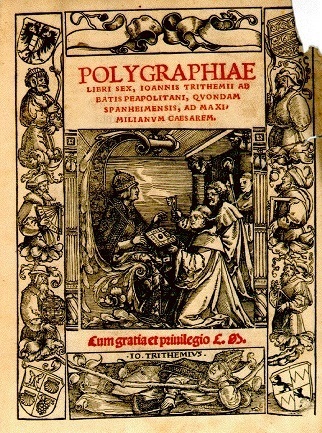
Johannes Trithemius' Polygraphiae
EXCERPTED FROM UNVEILING THE MYSTIC CIPHERS - There has been a close relationship between ciphers and mysticism ever since the first Egyptian scribe began experimenting with phrases on sacred tombs. From the Hebrew tradition of Kabbalah, to renaissance abbot Johannes Trithemius who purportedly used spirits to transmit concealed knowledge, as well as early doctors and chemists who used codes and symbols to conceal the secrets of alchemy, western mysticism and the art of concealing knowledge have always walked similar paths.
One story from Thomas Anson’s time illustrates this idea well. Across the English Channel, in the bustling city of Paris, the nobility of France were as intrigued as the rest of Europe by the growing fashion for the free exchange of ideas. Moreover, many shared a penchant for the mysterious, fascinated with the spread of secret societies and esoteric traditions. They hosted parties and invited charismatic and eccentric personalities, such as the androgynous French spy Chevalier d’Eon, Italian adventurer and occultist Alessandro Cagliostro, and the enigmatic Comte de Saint Germain, all of whom lived shadowy lives between the tangible courts of the elite and the legends of the esoteric underworld.
One Parisian noblewoman, Jeanne, Marquise d'Urfe, was as noted for her devotion to the occult as she was for her high position in society. After the loss of her husband and the death or estrangement of all of her children, she spent much of her time engrossed in the study of magic and alchemy, seeking the secrets of the alchemists’ magnum opus. She had great wealth, and had inherited a vast library full of works on magic, alchemy, and science, that no doubt included many of the volumes the Earl of Macclesfield held in his massive collection at Shirburn Castle.
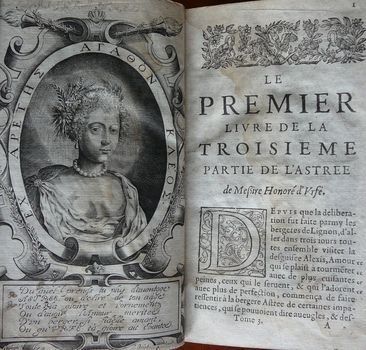
Jeanne Camus de Pontcarré , marquise d’Urfé
At one stage of her life, Mme. d’Urfe met a charming and mysterious Italian named Giacomo Casanova, the famed lover, confidence man and adventurer, who earned her good graces and ultimately her patronage. This was done in part through his ability to play upon her fascination with esoteric knowledge. In his autobiography, Casanova tells of a story in which we see the close connection between ciphers and mysticism.
He tells us of his first visit to Mme. d’Urfe’s estate, the dinner they had and some polite conversation afterwards in which the two began to get to know one another. It did not take long for the topic of conversation to turn to his host’s passion for learning, especially esoteric subjects. Casanova tells us that, “After the dessert … Madame d’Urfe began to discuss alchemy and magic, and all the other branches of her beloved science, or rather infatuation.” Upon discussing the various stages of the Great Work of Alchemy, Casanova learned that Mme. d’Urfe believed herself to possess a manuscript that described the secret process of transmuting lead to gold. He states, “She then shewed me a collection of books which had belonged to the great d’Urfe, and Renee of Savoy, his wife; but she had added to it manuscripts which had cost her more than a hundred thousand francs. … She shewed me a short manuscript in French, where the Great Work was clearly explained. She told me that she did not keep it under lock and key, because it was written in a cypher, the secret of which was known only to herself.”[1]
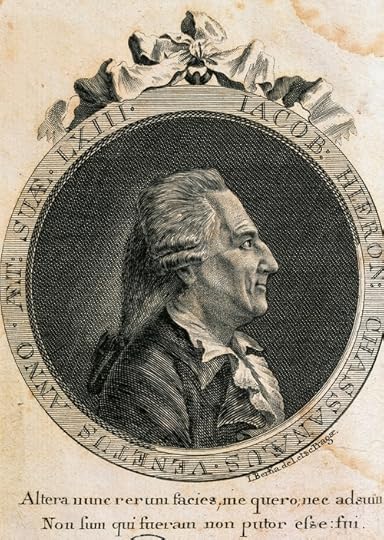
Giacomo Girolamo Casanova
The noblewoman gave a copy of the manuscript to Casanova as a challenge, believing that he could not decipher it. But weeks later, he surprised her by stating that he had read the enciphered text, coyly adding that it contained nothing he did not already know. As proof, he revealed to her the key she had used to encipher the text. To which Mme. d’Urfe responded, “This is too amazing, I thought myself the sole possessor of that mysterious word — for I had never written it down, laying it up in my memory — and I am sure I have never told anyone of it.”[2]
In closing his tale, Casanova relates the still-close connection between people’s understanding of ciphers and the occult, stating that “I might have informed her that the calculation which enabled me to decipher the manuscript furnished me also with the key, but the whim took me to tell her that a spirit had revealed it to me. This foolish tale completed my mastery over this truly learned and sensible woman on everything but her hobby. This false confidence gave me an immense ascendancy over Madame d’Urfe, and I often abused my power over her. “[3]
We might write off this tale as a wild embellishment told in order to make the memoirs more interesting, and to make Casanova appear to be more of a genius. But, we do possess evidence that Casanova was, in fact, well versed in the use of polyalphabetic substitution ciphers such as the one he describes. In fact, on a letter he wrote in 1791 exists a short enciphered text using the same cipher and the exact same key which Mme. d’Urfe zealously kept secret, the word “Nebucadnezzar”[4]. We cannot prove that he mathematically cracked her cipher, as he states (indeed, no record exists of a polyalphabetic cipher being broken by anyone until the next century), but a confidence man such as himself may have found other ways to reveal its secrets.
What we can take away from this story, however, is the fact that ciphers and esoteric fields of study went hand in hand during this period in history. In addition, the polyalphabetic substitution cipher appears to have been used often enough in such matters to have been relatively common among members of learned society. And finally, Casanova makes a point we will refer to in our decryption of the Shugborough cipher, which is that the cipher is basically a mathematical relationship between three variables: the cleartext, the ciphertext and the key. Once one knows the values of any two of these elements, it is quite possible to calculate the third.
[1] Casanova, Giacomo Chevalier De Seingalt. The Complete Memoirs of Casanova the Story of My Life. Oxford: Benediction Classics, 2013. 415.
[2] Casanova, 417
[3] Casanova, 417
[4] Winkel, Brian J. (1978) 'CASANOVA AND THE BEAUFORT CIPHER', Cryptologia, 2:2, 161 - 163
December 1, 2014
Excerpt from Unveiling the Mystic Ciphers
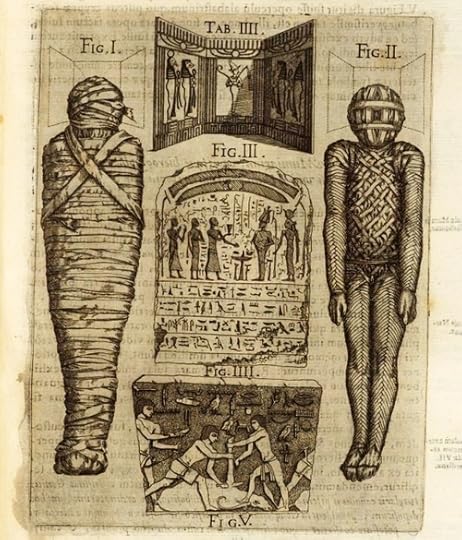
Egyptian funerary practices, from Athanasius Kircher’s Oedipus Aegyptachus.
In 1967 David Kahn wrote the first exhaustive history of cryptography, beginning with its earliest appearance thousands of years ago in Egypt and following its progress throughout history until modern times. In his examination of early cryptography, Kahn pointed out that the first recorded form of encryption was found in hieroglyphics on Egyptian tombs. The Egyptians were the first known authors to actively try to transform the writing from a basic sign, whose meaning was easily translated, into a more complex sign whose translation required more involvement on the part of the reader.
Why? Because this transformation added a second level of meaning to the text. The first was the standard, or plaintext meaning of the language. The second, deeper significance was the effect gained by using some means to alter the presentation of the text to the reader. A simpler, more straightforward symbol or word could have been used, but the author chose a more unique symbol to add a greater sense of dignity to the tomb, or to catch the eye of more readers. Eventually this led to what modern culture might see as word-games, which both challenged the reader and entertained them at the same time. Kahn states:
As Egyptian civilization waxed…these transformations grew more complicated, more contrived and more common…
…But many inscriptions are tinctured, for the first time, with the second essential for cryptology –secrecy. In a few cases, the secrecy was intended to increase the mystery, and hence the arcane magical powers of certain religious texts. But the secrecy in many more cases resulted from the understandable desire of the Egyptians to have passersby read their epitaphs and so confer upon the departed the blessings written therein…They introduced the cryptographic signs to catch the reader’s eye, make him wonder, and tempt him into unriddling them –and so into reading the blessings. [1]
From cryptography’s inception in antiquity through its development over time; from the middle-ages to the renaissance and the modern era, it has been inextricably connected to the intertwined worlds of religion, science and the occult. Language contains an elemental power. Secret language exponentially expands the perception of that power. It is no accident that the publications of many of the greatest innovators in cryptography, such as Johannes Trithemius and Blaise de Vigenère, often delve just as deeply into esoteric studies of religion, alchemy and occult knowledge as they do into the art of encryption. Perhaps this is the reason why the mystery of secret writing, whether on an ancient tomb or in a Sherlock Holmes novel, creates an intoxicating lure for the curious mind.
In the modern era this connection has lessened somewhat, especially as technology has accelerated the capabilities and prevalence of cryptography in every aspect of daily life. Specialists in the area are now mathematicians and engineers, not historians, clerics and alchemists. The mystery has faded. The mixtures of disciplines have separated. Now they present themselves as independent fields of study, neatly arranged on different pages of our college course catalogs. Some have disappeared altogether. And cryptography is now a commodity to be purchased on the common market and deployed by the masses, with little or no understanding of its functional workings or the context of its development.
Much of the early fascination of cryptographic mysteries is gone, but some esoteric puzzles still remain. The Shepherd’s Monument is one of them. It crosses the timeline of cryptographic history at that point just as the magic was fading, as science began to ascend to the throne of knowledge and divorce itself from other less tangible fields. Here, an English gentleman at the crossroads of the Rosicrucian Enlightenment and the Scientific Revolution set in stone a marble picture and ten cryptic letters. At this unique moment in time, Thomas Anson built a monument which holds a secret. A Shepherdess’s Tomb whose inscription, like those Egyptian tombs thousands of years before it, begs us to spend some time working out its ciphers. They catch our eye, make us wonder, and tempt us into unriddling them –and so perhaps, into reading their blessings.
[1] Kahn, David. The Code Breakers: The Comprehensive History of Secret Communication from Ancient Times to the Internet, (New York: Scribner, 1996), 71-72.
July 26, 2014
Pop's Last Post
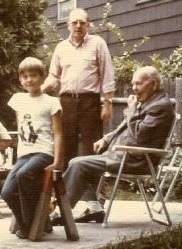
I was in my grandfather’s hospital room in the late 1970’s
when a doctor came in to go over his medical history. My grandfather, who was
both pleasant and a bit stoic, answered the questions matter-of-factly, but in
a thick Yorkshire brogue which I secretly loved to hear. The initial question
was very basic, but the answer surprised us all.
“When was the last time you saw a doctor?” the young intern
asked.
“1917” was Pop’s reply.
The intern looked to us with raised eyebrows. Clearly he
felt this was a mistake, and that my ninety something patriarch was not of
sound mind. But Pop was still quite sharp, and we indicated that the doctor
should continue to ask him the questions.
“And what were you hospitalized for?”
“My leg”
“What was wrong with your leg at the time?”
“It had a piece of the Kaiser's shrapnel in it”
“And you’ve never been to a hospital since?”
“No.”
That was it, no story, no bragging, no lecturing this youngster
about never needing doctors, no reminiscing about the war. Get on with it.
Of course, as a young boy, the scene stuck out in my mind. I
was determined to find out more about Pop’s wartime experiences. But, with his advanced
age, one hospitalization led to another, and in due time we said goodbye to Pop
and lost him from this world.
Last week, while going through family papers, I came across
Pop’s war diary from the First World War. His words were succinct, as usual,
but here is his story, as best I can relate.
My grandfather, George Herbert Ramsden, was born in the city
of Wath-on-Dearne, in the West Riding of Yorkshire, England, in 1885. He spent
most of his early life in Bingley, where he was indentured in an apprenticeship
to learn the painting trade. His father was a cook, who ran a fish and chip
shop. As a young man, he and his friends would stroll the lanes of Bingley in
the evening,
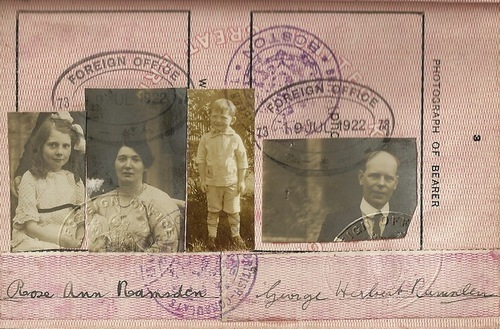
singing songs to the girls who strolled the same lanes. It was
there that he met Rose Ann Oldfield, a collier’s daughter. After courting for
some time, he proposed to her one day at Druid’s altar, an old stone formation looking
out over the moors. On the day they were married, he was so excited when he saw
her appear at the back of the church that he ran to her and walked her down the
aisle himself.
Rose had several
relatives who had emigrated from England to the United States and were living
outside of Boston, Massachusetts. The two decided to join them and look for
opportunity there, so in the early 1900’s they crossed the Atlantic and began a
new life in America. They had a daughter, Irene, in 1911. A few years later, in
1914, fighting broke out in Europe and England joined France and Belgium in
fighting Kaiser Wilhelm and the German Army on the Western Front.
Despite the fact that my grandfather was now 30 years old,
with a young family, successfully settled in a new country, his sense of duty
was calling him back to England. And even though the Germans declared a
submarine blockade around England, sinking every ship they found, George, Rose
& Irene set sail back to their homeland. The journey was uneventful, save for
a friendship that the family (especially 4 year old Irene) developed with the
Captain. When the trip was over the Ramsden family settled back in Yorkshire,
but the Captain and the ship were both lost to the German submarines on their
return trip to America.
Back in England Pop
enlisted in the Army and became a member of the Black Watch. The Black Watch
were a Scottish regiment, known as “the Ladies from Hell” because they would proudly
wear their kilts into battle. In due time he was trained as a machine gunner
and sent across the channel with his regiment to join the troops in Northern
France. They moved across France and Belgium with full packs, to places like Camiers,
Marquay, Arras, Fampoux, St. Julien, St. Omer, St. Momelin, Poperindge and finally
Ypres. At Ypres the English troops had trouble pronouncing the city’s name
properly, so they took to calling it “Wipers”.
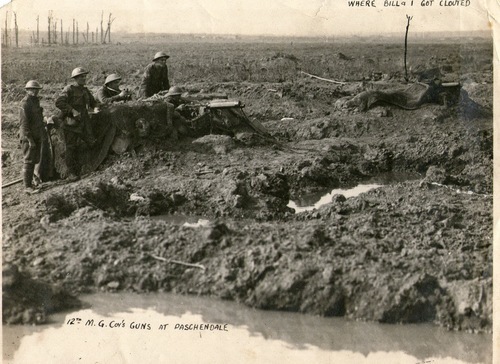
In Ypres Pop was put to work as a runner, possibly because
of his maturity. Runners were charged with hand delivering orders from Brigade
headquarters out to the commanders on the front lines, whose positions could
change daily with no regular means to communicate the changes. This was not
always an easy job, in a country full of mazes of trenches and barbed wire,
pillboxes and shelled out forests. One day he was delivering a message in a new
section of countryside and he became disoriented. The lane he was on forked,
and he was too close to the German front lines to risk going the wrong way. He
paused for a time, in doubt over what to do, but as he rested there a cat
suddenly emerged out of the lonely landscape and, looking back at him, walked
away down one of the paths. Pop chose to follow the cat, and it led him safely
to the allied lines.
At night he slept in “the tunnels” as he called them. These
were huge expanses of underground tunnels dug by volunteer Sappers recruited
from the coal mines of Wales and Yorkshire. They housed the English troops deep
underground, out of danger from German artillery, and gave the miners an
additional launching point to tunnel under the German lines and plant
explosives. Even today the farms in that countryside are dotted with craters
that testify to the “clay-kickers” who carried out such destructive and
demoralizing operations against the enemy.
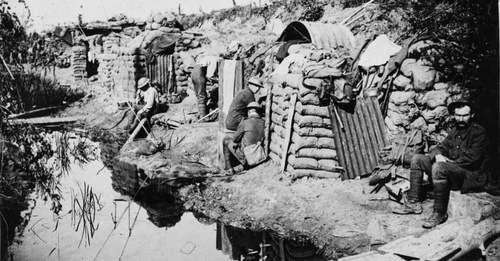
In July of 1917, Pop
was stationed just north of Ypres on the Yser canal bank, just in front of
Pilckem Ridge. He regularly ran messages to the front, while the English Army
began gearing up for a major offensive. Daily artillery activity increased
shelling of the German lines, and the Germans responded with barrages of their
own. On July 2
nd
his diary relates heavy shelling of their positions
towards morning. During this period, he also acted as a guide, joined work
parties in repairing the trenches, and both wrote and received a number of
letters from home.
On July 31, 1917, Pop awoke and was ordered to Headquarters,
where he was given a message to deliver to Major C.C.L. Barlow of the
Lincolnshire Regiment. His diary tells the story quite clearly:
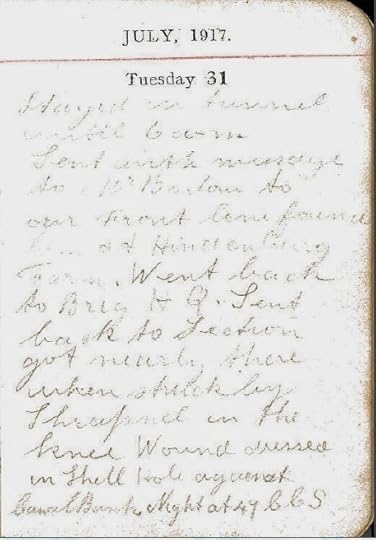
Stayed in tunnel until 6 a.m. Sent with message to Major Barlow to our
front line. Found him at Hindenburg Farm. Went back to Brig H.Q. Sent back to
Section got nearly there when struck by shrapnel in the knee. Wound dressed in
shell hole again at canal bank. Night at 47 C.C.S.
47 C.C.S. was the Casualty Clearing Station. The next day he
was moved by train to Camiers, where he was treated in a hospital for a few days
and then put on a hospital ship and sent back to England for his recovery at
Oxford. The wound probably saved his life, for what he did not know was that
July 31, 1917 was the very first day of the Battle of Passchendaele, also known
as the 3
rd
Battle of Ypres.
The engagement lasted more than four months, until early
November. The unimaginable battlefield conditions are legendary. After
English artillery softened the German positions with over one million artillery rounds, record
rainfall hit the region and turned the battlefield into a mass of mud and
flooded shell holes. Men and horses became stuck in the mire and literally
drowned in the mud. Meanwhile, wave after wave of men perished in a futile
effort to gain mere yards of territory. The first wave of English troops to
attack were driven back by the Germans, suffering 70% casualties. By November
when the battle ended, nearly 250,000 English troops had perished on the
battlefield along with approximately 400,000 Germans. Major Barlow, who
received Pop’s message from H.Q. that morning, lived until November but died
just days before the battle was over, though his remains were never able to be
recovered. He is memorialized in a cemetery in Belgium.

To this day the
Belgians honor the fallen who came to defend them in a daily ceremony that has
been conducted without fail from July of 1928 until this day (with the only
exception being during the Second World War, when they were under German
occupation, again). The solemn ceremony, called “the Last Post”, is conducted
at the Menin Gate in Ypres at dusk each day. Traffic is stopped while a bugle plays the tune that would
sound the end of the day to English lines.
Pop was lucky to have made it out of the war alive, and
though his story possesses no standout heroics, learning it helped me to understand
the true sacrifice of his generation, which even now is fading from our
collective memory. This week will mark the 100
th
anniversary of the
outbreak of the war to end all wars. It also marks the 98
th
anniversary
of the battle of Passchendaele, and of my grandfather’s 1917 trip to the
hospital. Peace.
November 25, 2013
Arcade Fire and the Gnostic Afterlife
Arcade Fire’s recently released Reflektor album is receiving critical praise, and as usual their
music is being delivered to the public through a variety of entertainment
mediums. From the digital album to an
SNL appearance, PBS audio concert, 30 minute short TV special, award show spots
and music videos in multiple formats from traditional to the interactive. Case
in point: with the single Afterlife, music
fans can enjoy several video versions of the song. These include a live
performance directed by Spike Jonze, a video version using footage from Marcel
Camus’ “Black Orpheus”, and an official video written and directed by Emily Kai
Bock.
Bock, a Canadian filmmaker
who released her video as part of the Creators Project, has received
high praise for the short film, featuring a Hispanic father and
two sons who are suffering through the loss of their family matriarch.
Christopher Rosen, writing in the Huffington Post, even declared that “Arcade Fire's ‘Afterlife’ video is better
than a lot of this year's feature films.”
Most reviews refer to the work as melancholy, emotional and struggling to make
sense of personal loss. But, though true, these observations are just touching
the surface of this piece of art, and the trinity of films in general.
Beneath the
exoteric tale of family loss and coping lies a deeper philosophical theme which
runs through many of Arcade Fire’s other works, as well. The esoteric ideas
behind this Afterlife film explore a gnostic
philosophy. These ideas clash against the backdrop of a traditional Latino family
with Roman Catholic beliefs. This is a theme Win Butler often adopts, creating
tension by exploring the contentious relationship between gnostic ideas and
those promoted by Catholic and Evangelical Christians.
Just as the film “Black
Orpheus” borrows from the classical orphic mystery school, telling a mythic
story in which the male-female relationship bridges into the underworld that is
the afterlife, Arcade Fire explore the same themes in Emily Kai Bock’s work.
Except, in Bock’s work, the tension is developed through displaying the void
created by a male-dominated system which eliminates the role of the feminine
divinity.
 In Bock’s film,
In Bock’s film,the father represents a version of the Gnostic demiurge, a male
creator/provider. He is flawed without his female counterpart, and is not adequately able
to provide for the family. It is this lack of the
divine female influence that is the root of the family’s troubles, but the father
is at a loss, unable to supply the feminine aspects of parenthood to his children and even failing in his own paternal role without the help of his soul-mate. His stern and controlling
nature is hanging on to what he knows, but blind to his faults. He denies his
eldest son’s request to go out into the world because he is overprotective and tired. In reality, the eldest son will suffer the same fate if bound to this hopeless, isolated existence. As the son sneaks off to enter the world, we are briefly shown a portrait of this him next to a portrait of
Jesus, setting up a comparison of the sons and of the fathers as well.
 In a dream the
In a dream theeldest son visits a housing complex and passes by three women, at least one of whom
eyes him as a potential lover. But he passes them by without engaging them and
instead focuses his attention on a baptism being performed in a pool
behind a locked gate. He, too, is suffering because of his denial of the real sensual
female presence around him and his fixation on a pure Christianized idea of the
female that lies beyond his reach. By remaining pure and focusing on the
promised afterlife, he is denying himself the female presence he so desperately
needs in this life now that his mother is gone.
 The younger son,
The younger son,too, dreams of a female figure but she is a burly matronly woman, dispassionately
engaged in cleaning bed sheets in a Laundromat. There is no love, only
antiseptic purification, and the boy is horrified to find that he too is being
callously locked in a machine to be washed, as well.
Both boys are touched
in their dreams by the comfort of their real mother, who is gone from the world
they know. They clearly need her and she longs to be with them, but this
reunification is impossible in their world. It is clear that in three different
aspects, maiden, mother and wife, the female figure is missing and desperately
needed.
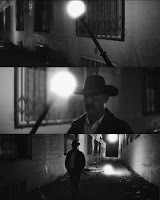 Ultimately, the
Ultimately, thefather makes a midnight dream journey through the streets and into the
underworld to reach her. He passes a lamp which leans across the street and quietly
falls to the ground behind him, symbolizing the female light of the gnostic
Sophia falling to the material realm of earth.
He then journeys
through the material world, represented by the mining facility filled with
mountains of earth, and ultimately descends into the underworld through the
cellars of the factory. In the basement he finds his love, dressed in mourning
clothes, and upon embracing her is able to see shafts of light coming from heaven
above. But alas, it is just a dream.
 In the final moments of the film we are
In the final moments of the film we areleft with the despondency of the three men together on the couch, bathed only
in the electronic light of the television. It is a lonely, desperate film,
populated by characters who do not understand the root of their own problems,
but who feel it deeply in their subconscious.
Curiously, the melancholy
extreme of Emily Kai Bock’s film is counter-balanced by the exuberant joy displayed in the Spike Jonze performance.
In fact, by creating three versions of videos for the song, Arcade Fire achieved
some symmetry. In the center lies the version taken from clips of “Black
Orpheus”, with both male and female elements struggling passionately with love
and against their own mortality. To the right of this is Bock’s
male-dominated version, unable to come to grips with its lack of feminine
influence and mired in despondency. On the left lies the Spike Jonze version, which showcases a woman who, free from her male companion, dances joyfully on
a stage amongst a bevy of young girls. In the end, perhaps the band is trying
to tell us that unity and balance is the only path to happiness in this life,
and perhaps in the next one as well.
June 23, 2007
Standing on the Shoulders of Giants
 Consider a few examples of context: a team wins a baseball game. Your child’s team wins a little league game. He or she catches the game winning ball. Bill Buckner makes a game losing error. The Red Sox win the 2004 World Series, defeating the 86 year-long curse of the Bambino. Each variable that leads up to an event or a moment in time contributes different levels of meaning to it, some more or less than others.
Consider a few examples of context: a team wins a baseball game. Your child’s team wins a little league game. He or she catches the game winning ball. Bill Buckner makes a game losing error. The Red Sox win the 2004 World Series, defeating the 86 year-long curse of the Bambino. Each variable that leads up to an event or a moment in time contributes different levels of meaning to it, some more or less than others. We recently changed the naming convention of our conference rooms at my company. “Why Turing?” I have been asked by some. “Why did the names change at all?” “What was wrong with Michelangelo?”
The answer is historical context. Nothing was wrong with our old names, but they really didn’t contribute towards or derive from anything that we do. My company is a manufacturer of services within the technology industry. When we look at the term “technology” we probably think about what is going on today and tomorrow at the bleeding edge of internet applications, personal gadgetry and electronic entertainment. But we are less likely to look over our shoulder, at the individuals whose contributions to the fields of science, mathematics and computing led to this era of exponential growth in technological achievement.
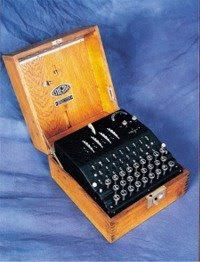 Our choice of names for the places where ideas are exchanged derives from a desire to understand and appreciate the context within which our business exists. Before BGP, Unified Communications and Vista there were super-computers, Enigma, Turing machines and punch-card tabulators. And before that there were the revolutionary concepts of physics, mathematics, geometry and the natural sciences which paved the way for those of us who follow.
Our choice of names for the places where ideas are exchanged derives from a desire to understand and appreciate the context within which our business exists. Before BGP, Unified Communications and Vista there were super-computers, Enigma, Turing machines and punch-card tabulators. And before that there were the revolutionary concepts of physics, mathematics, geometry and the natural sciences which paved the way for those of us who follow. History testifies that for hundreds of years, the sciences of the western hemisphere languished in the intellectually stagnant era commonly (and aptly) called the Dark Ages. Although Arab studies of mathematics and science reached a zenith of intellectual development at this time, Europe did not participate until the 15th century, when the fall of Constantinople and the opening of new trade routes brought a flood of new ideas, new cultures and new economic opportunities into the trade cities of Italy. With this long overdue arrival of the Renaissance, a new period characterized by innovation and the growth of scientific thought began to emerge.
This is where we begin to see the individual contributions of great minds to the growth of western science. The men who stood out made great strides, often at the expense of their reputations, their freedom and at times, their lives. The best, though, challenged the process and the accepted knowledge not out of the yearning for indiscriminant rebellion, but rather out of a quest to better understand the truths behind the mysteries of the world, and a desire to do something positive with the knowledge they might gain.
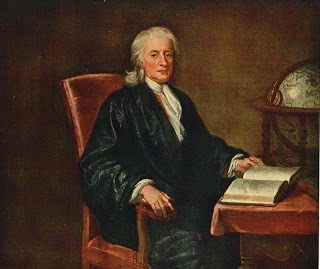 As a result, we see men like Copernicus, Galileo, and DaVinci challenging the intellectual culture around them with ideas which ultimately proved to be groundbreaking in the course of human development. Moreover, they were followed by contributions from minds like Sir Isaac Newton, who is famous for the statement “if I have seen further, it is by standing on the shoulders of giants.” Newton understood the tradition within which he operated, and the debt owed to his predecessors.
As a result, we see men like Copernicus, Galileo, and DaVinci challenging the intellectual culture around them with ideas which ultimately proved to be groundbreaking in the course of human development. Moreover, they were followed by contributions from minds like Sir Isaac Newton, who is famous for the statement “if I have seen further, it is by standing on the shoulders of giants.” Newton understood the tradition within which he operated, and the debt owed to his predecessors. In our own century, Albert Einstein perhaps best typifies this sense of incredible talent, built upon the countless achievements of others before him and driven on by his own unique personal genius. Moreover, in our own specific industry, we must count the name of Alan Turing, the British logician, mathematician and cryptographer. Known as the father of modern computing and famed for his WWII decrypting contribution at Bletchley Park, his studies built upon both Newton and Einstein’s work in physics and mathematics, ultimately leading to the concept of theoretical machines capable of performing any given mathematical computation. Turing Machines are a central concept in modern computing theory, whose abstract properties lend many insights into both computer science and complexity theory.
We do not operate in a vacuum, and the work we do does not end when we are gone. Though we may not ever become the topics of university lectures, which of us would ever strive for obscurity? The contributions we make will extend beyond our lives, and any greatness we achieve in our own right may enable others to reach new heights of their own. We are a business, but we are also learning organization with a remarkable desire to propel self-development, taking what is good and making it great. We should never settle for mediocrity, and we should never forget the shoulders on which we stand.
May 4, 2007
Rosslyn Chapel Stone Mystery Decoded
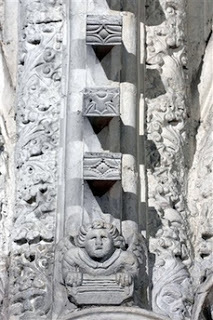 Check out the story below and play the video. It's well worth your time if you are as hip as most readers of this blog. For the uninitiated, Rosslyn Chapel is one is one of the most unique medeival churches in the British Isles, decorated with a host of cryptic stone symbols and architectural anomolies, and which is held dear by the Knights Templar and Freemasons alike. This is an unexusable oversimplification of hte site, but I will sum it all up with the additional statement that it is held to be one of several possible resting places of the Holy Grail.
Check out the story below and play the video. It's well worth your time if you are as hip as most readers of this blog. For the uninitiated, Rosslyn Chapel is one is one of the most unique medeival churches in the British Isles, decorated with a host of cryptic stone symbols and architectural anomolies, and which is held dear by the Knights Templar and Freemasons alike. This is an unexusable oversimplification of hte site, but I will sum it all up with the additional statement that it is held to be one of several possible resting places of the Holy Grail.ASSOCIATED PRESS- The stone carved angel, bottom, and cubes that lead a team of code-breakers to claim to have found music hidden for 500 years in the intricate carvings, are seen at Rosslyn Chapel, in the village of Roslin, near Edinburgh, Scotland Wednesday May 2, 2007. Father and son team Thomas and Stuart Mitchell say they deciphered a musical code hewn into stone cubes on the ribs supporting the ceiling of Rosslyn Chapel. The music has been recorded, and will get its official premiere in the chapel May 18. Rosslyn Chapel is where author Dan Brown set the climax of the best-selling book 'The Da Vinci Code.' (AP Photo/Gordon Frazer)



